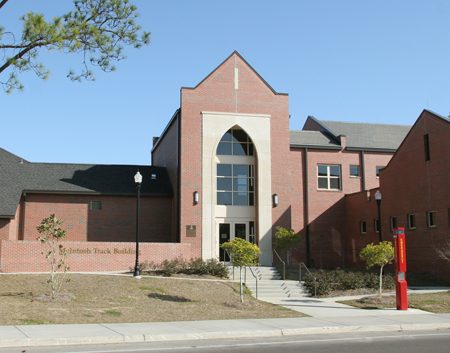
Thanks to its state-of-the-art McIntosh Track and Field Building, The Florida State University can add "silver" and "green" to its garnet and gold. The new facility has earned a LEED Silver Certification from the U.S. Green Building Council, which means it meets or exceeds the high standards of green-building design and performance.
LEED stands for "Leadership in Environmental and Energy Design," and there’s plenty of it in the two-story, 19,000-gross-square-foot structure, which overlooks Mike Long Track and serves as the base of competitive and tournament operations and student-athlete services for the track-and-field program. While the university currently has eight other LEED projects in the works, the McIntosh Track and Field Building — one of the nation’s finest facilities of its kind — is the first Florida State campus project to be officially LEED Certified.
"We are thrilled to deliver our first LEED Certified project," said Larry Rubin, Florida State’s director of Facilities Design and Construction. "The McIntosh Track and Field Building is an energy-conscious facility that not only represents the right thing to do but also enables Florida State to save money over the long run by conserving energy and resources."
To become LEED Certified, an applicant must earn at least 26 hard-to-get points out of 69 in five out of six categories: sustainable sites; water efficiency; energy and atmosphere; materials and resources; indoor environmental quality; and innovative design.
To achieve its LEED Silver designation, which requires a total of 33-38 points in at least five categories, the McIntosh Track and Field Building went the extra mile required by the U.S. Green Building Council, whose building performance standards promote sustainability through energy-efficient design and responsible use of materials and resources.
"We reused or renovated sections of the existing track building and expanded it with new construction," Rubin said. "We used local or regional materials to save on transportation and trucking; energy-efficient lighting and mechanical systems; low-flow water fixtures; sorted or recycled construction debris; and low-VOC (volatile organic compound) paints and other eco- and sustainable finishes."
Rubin says a Silver rating is within reach for most of the university’s other construction projects as well, and because of smart design guidelines, it’s doable without adding significantly to up-front costs.
The building was named in honor of Mike and Winsome McIntosh, who became fans of Florida State when their son Mark was recruited to the Seminole track team. Over the years they have donated more than $1.5 million (of which $500,000 was committed to build the track training facility) to the university.
Mike McIntosh is president of the charitable foundation that is run by the McIntosh family. Its focus is environmental grant making.
"Upon graduating from the Choate School at 18 most of my classmates got cars," he said. "My folks gave me a lifetime membership in the Sierra Club. It stuck. Representing the McIntosh Foundation, one of the founders of the Natural Resources Defense Council (NRDC) and a long-time supporter of Earthjustice, both environmental law firms dealing with conservation issues, we couldn’t be more pleased that the Track and Field Building carrying our name has received the LEED Silver Certification. Both the university and especially its Design and Construction department should be very proud of their accomplishment."
Florida State University formally dedicated the McIntosh Track and Field Building last November. With a total project budget of about $5.8 million, it was designed by Barnett Fronczak Barlowe Architects and built by Childers Construction Company.




